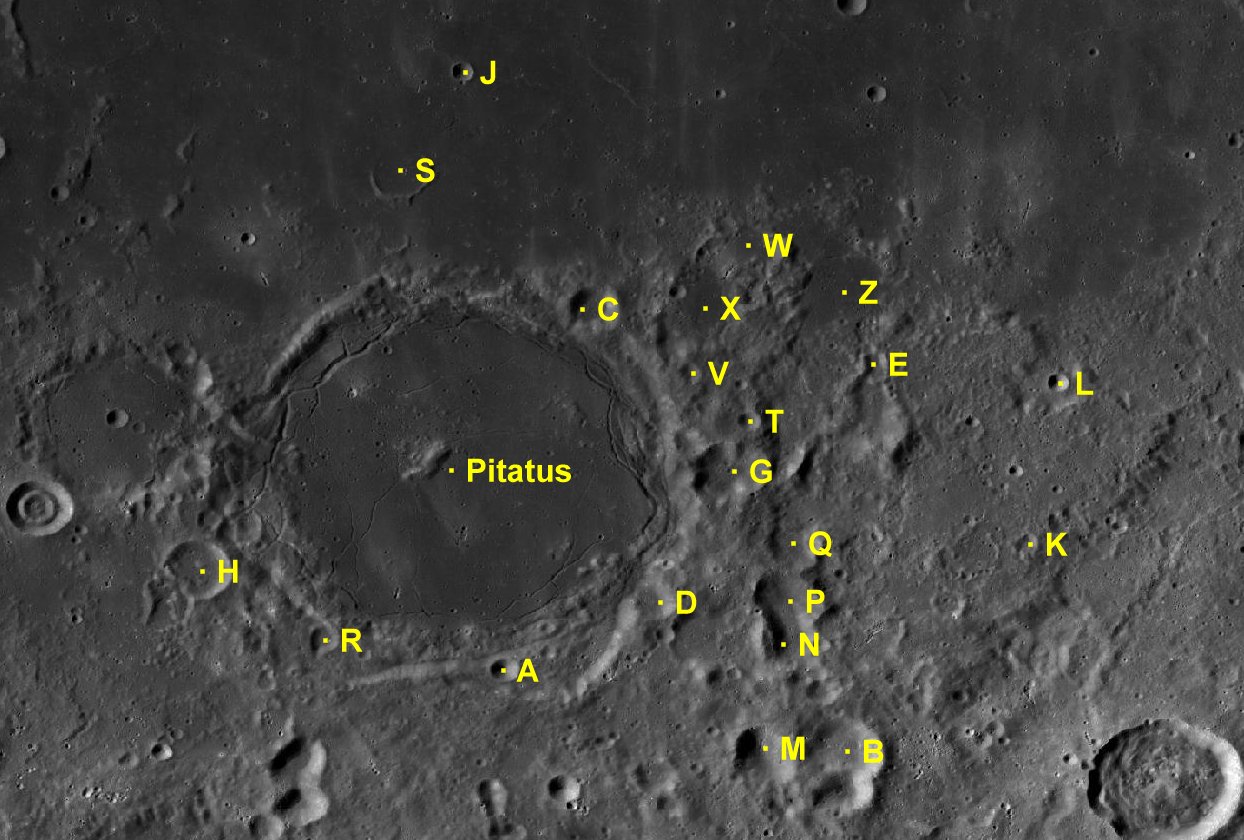Pitatus (crater) on:
[Wikipedia]
[Google]
[Amazon]
 Pitatus is an ancient
Pitatus is an ancient
The geologic history of the Moon
 By convention these features are identified on lunar maps by placing the letter on the side of the crater midpoint that is closest to Pitatus.
By convention these features are identified on lunar maps by placing the letter on the side of the crater midpoint that is closest to Pitatus.

 Pitatus is an ancient
Pitatus is an ancient lunar
Lunar most commonly means "of or relating to the Moon".
Lunar may also refer to:
Arts and entertainment
* ''Lunar'' (series), a series of video games
* "Lunar" (song), by David Guetta
* "Lunar", a song by Priestess from the 2009 album ''Prior t ...
impact crater
An impact crater is a depression (geology), depression in the surface of a solid astronomical body formed by the hypervelocity impact event, impact of a smaller object. In contrast to volcanic craters, which result from explosion or internal c ...
located at the southern edge of Mare Nubium
Mare Nubium (Latin ''nūbium'', the "sea of clouds") is a lunar mare in the Nubium basin on the Moon's near side. The mare is located just to the southeast of Oceanus Procellarum.
Formation
The basin containing Mare Nubium is believed to ...
. It was named after Italian astronomer Pietro Pitati by the IAU
The International Astronomical Union (IAU; , UAI) is an international non-governmental organization (INGO) with the objective of advancing astronomy in all aspects, including promoting astronomical research, outreach, education, and developmen ...
in 1935. Joined to the northwest rim is the crater Hesiodus, and the two are joined by a narrow cleft. To the south lie the attached Wurzelbauer and Gauricus.
Description
The complex wall of Pitatus is heavily worn, and has been encroached bylava
Lava is molten or partially molten rock (magma) that has been expelled from the interior of a terrestrial planet (such as Earth) or a Natural satellite, moon onto its surface. Lava may be erupted at a volcano or through a Fissure vent, fractu ...
flows. The rim is lowest to the north, where the lava
Lava is molten or partially molten rock (magma) that has been expelled from the interior of a terrestrial planet (such as Earth) or a Natural satellite, moon onto its surface. Lava may be erupted at a volcano or through a Fissure vent, fractu ...
almost joins the Mare Nubium
Mare Nubium (Latin ''nūbium'', the "sea of clouds") is a lunar mare in the Nubium basin on the Moon's near side. The mare is located just to the southeast of Oceanus Procellarum.
Formation
The basin containing Mare Nubium is believed to ...
. Near the middle is a low central peak that is offset to the northwest of center. This peak only rises to a height of 0.5 km.
Pitatus is a floor-fractured crater, meaning it was flooded from the interior by magma
Magma () is the molten or semi-molten natural material from which all igneous rocks are formed. Magma (sometimes colloquially but incorrectly referred to as ''lava'') is found beneath the surface of the Earth, and evidence of magmatism has also ...
intrusion through cracks and openings. (See also Gassendi and Posidonius
Posidonius (; , "of Poseidon") "of Apameia" (ὁ Ἀπαμεύς) or "of Rhodes" (ὁ Ῥόδιος) (), was a Greeks, Greek politician, astronomer, astrologer, geographer, historian, mathematician, and teacher native to Apamea (Syria), Apame ...
for similar features.) The flooded crater floor contains low hills in the east and a system of slender clefts named the Rimae Pitatus. The larger and more spectacular of these rilles follow the edges of the inner walls, especially in the northern and eastern halves. The floor also contains the faint traces of deposited ray markings.
Just to the north of Pitatus in the neighboring mare
A mare is an adult female horse or other equidae, equine. In most cases, a mare is a female horse over the age of three, and a filly is a female horse three and younger. In Thoroughbred horse racing, a mare is defined as a female horse more th ...
is the half-buried rim of Pitatus S, covered in the past when Mare Nubium
Mare Nubium (Latin ''nūbium'', the "sea of clouds") is a lunar mare in the Nubium basin on the Moon's near side. The mare is located just to the southeast of Oceanus Procellarum.
Formation
The basin containing Mare Nubium is believed to ...
was formed.
Pitatus is a crater of Nectarian
The Nectarian Period of the lunar geologic timescale was from 3.920 billion years ago to 3.850 billion years ago. It is the period during which the Nectaris Basin and other major basins were formed by large impact events. Ejecta from Nectaris for ...
age.USGS
The United States Geological Survey (USGS), founded as the Geological Survey, is an government agency, agency of the United States Department of the Interior, U.S. Department of the Interior whose work spans the disciplines of biology, geograp ...
Professional Paper 1348. By Don E. Wilhelms, John F. McCauley, and Newell J. Trask. U.S. Government Printing Office, Washington: 1987. Table 9-4.
Satellite craters
 By convention these features are identified on lunar maps by placing the letter on the side of the crater midpoint that is closest to Pitatus.
By convention these features are identified on lunar maps by placing the letter on the side of the crater midpoint that is closest to Pitatus.

References
* * * * * * * * * * * {{Commons category Impact craters on the Moon